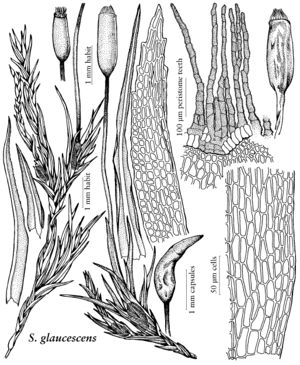Saelania glaucescens
in J. O. Bomansson and V. F. Brotherus, Herb. Mus. Fenn., Musci, 53. 1894,.
Leaves 1–2.5 (–3.5) mm, proximal leaves small, the distal and perichaetial leaves gradually acuminate, ± subulate from a lanceolate base; costa with a single row of guide cells, and both adaxial and abaxial stereid bands, or adaxial stereid band sometimes weak or rarely absent; lamina cells often irregularly 2-stratose towards the apex and occasionally elsewhere. Seta to 15 mm. Capsule with operculum to 1 mm. Spores 15–20 (–22) µm, greenish to yellowbrown.
Phenology: Capsules mature early summer–late fall.
Habitat: Soil on steep banks, particularly those protected by overhangs, frequent on roadsides, soil in sheltered rock crevices
Elevation: moderate to high elevations
Distribution
Greenland, Alta., B.C., Man., N.B., Nfld. and Labr. (Nfld.), N.S., Ont., Que., Yukon, Alaska, Ariz., Colo., Iowa, Mich., Minn., Nebr., N.J., N.Y., n Eurasia, e Asia, s Africa, Pacific Islands (Hawaii), Pacific Islands (New Zealand)
Discussion
The whitish to bluish coloration of the leaves is characteristic. Often thought to have been fungal or cyanobacterial in origin, the granular or thread-like surface material responsible for the glaucous coloration is a diterpene.
Selected References
None.
